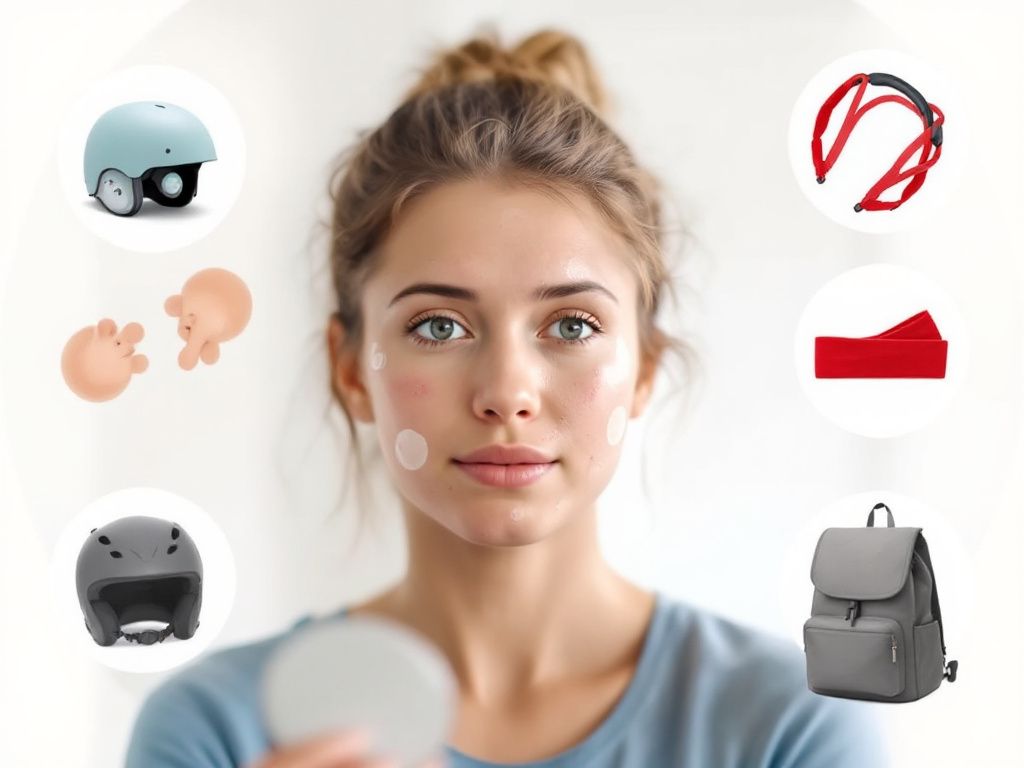So, have you ever wondered why some folks seem to get breakouts in places that seem, well, not so typical? Pimples on your forehead beneath a cap, or around the jawline after a day with your pop’s old motorcycle helmet? If you’ve pondered this, then congrats because you’re about to dive into the world of **mechanical acne basics**. This guide might just have that mix of science and practical advice you didn’t know you needed.
Table of Contents
ToggleWhat’s the Deal with Mechanical Acne?
Mechanical acne. Sounds fancy, right? But it’s really just a fancy term for breakouts caused by friction, pressure, or even heat against your skin. Imagine wearing a snug headband all day—yep, that might just trigger this type of acne. Let’s keep this simple; it’s not the cookies you snuck in last night (though they might contribute in other ways!), but that daily contact that’s at fault here.
Friction, Pressure, and Heat: The Trouble Trio
Now, here’s where our story gets juicy. The culprits behind mechanical acne are pretty straightforward: consistent friction, pressure, and heat. Imagine athletes who often wear helmets or use gear that rubs against their skin repeatedly. It’s not just athletes, though, anyone can fall prey to these physical triggers.
- Friction: Constant rubbing—think sports bras, caps, and tight collars.
- Pressure: Things like heavy bags on shoulders can cause irritation and lead to acne flares.
- Heat and Sweating: You know when your skin gets clammy from gear or hats? Yeah, that warmth and sweat can aggravate things.
Recognizing the Clues of Mechanical Acne

You might now be wondering—how do I know if those blemishes on my back are because of my backpack or just random acne? Good call. The key often lies in the pattern and location.
Patterns and Locations
- Visual Cues: These breakouts usually appear in straight lines or patterns that mimic your clothing or gear.
- Common Zones: Forehead, chin, back, and jawline—pretty much anywhere your skin meets consistent contact with objects or fabric.
Diving Deeper: The Science Behind It
I don’t know about you, but I find it fascinating to figure out what really goes on under the surface. When you look at mechanical acne, it’s all about what happens when your skin gets irritated. Friction breaks down the skin’s protective barrier, making it a hotbed for bacteria and clogging with oils—a recipe for classic acne.
Conquering Mechanical Acne: Steps to Reclaim Your Skin
Alright, enough with the bad news. Let’s talk solutions. Because trust me, you’re not alone in this journey, and there are ways to outsmart mechanical acne.
1. Clever Clothing Choices
First things first, give your wardrobe a mini-makeover. Steer towards looser fits and breathable fabrics. Cotton, yeah—a classic, keeps your skin breathing and prices are usually gentle on the wallet. Also, switch it up as soon as you can after sweating. The less time your skin stays sweaty and squished against fabric, the better.

2. Gear Up Smart
Those hats, helmet, and other gear? Potential culprits, for sure. If you can, go for something with better ventilation. For that bike helmet you can’t change, try adding a bandana as a buffer between your skin and the pressure points.
3. Skincare Know-How
Your skin needs a little extra care with all this going on. Remember to cleanse gently but thoroughly. Exfoliation will be your best friend, helping to whisk away dead skin cells that might otherwise clog your pores. Look for products with salicylic acid or benzoyl peroxide—they’re often effective against acne without being too harsh.
4. Be Strategic About Sweat
Whether you’re running a mile or just getting through a warm day at work, when sweat mixes with the oils on your skin and any bacteria nestled in, it can clog your pores. Wipe it off gently rather than letting it dry on your skin.
5. Balanced Hygiene Practices
Understandably, now you might overdo washing or scrubbing. But a word of caution—stripping your skin of its natural oils might just backfire. Think balance, not aggression.
Common Missteps and How to Avoid Them

Avoid these pitfalls for smoother sailing:
- Neglecting the Basics: Forgetting face wash after workouts or staying in sweaty clothes? Big no-no.
- Over-Scrubbing: More scrubbing might sound better—but this isn’t about elbow grease.
- Ignoring Gear Fit: If that backpack strap is digging in, consider padding or adjustments.
Is It All Just Bad News?
Nope, definitely not. Consider this: identifying and understanding mechanical acne basics can actually liberate you from unnecessary worry about mystery skin outbreaks. Plus, there’s something super empowering about knowing what’s happening with your body, and having concrete steps to tackle it.
Sure, it takes a few changes here and there, and a sprinkle of patience, but soon enough, you’ll know exactly which of your habits were the sneaky triggers.
Final Thoughts
We’ve rambled a bit, but let’s circle back one last time: Your battle with acne is unique, and mechanical acne basics give you a specific toolset to assess and address these breakouts. Recognize patterns, uncover the friction causes, and apply the steps closely resembling a trusted friend’s practical advice—because that’s exactly what this guide aims to feel like.
So, go ahead, give it some thought, take a note or two, and trust me—the next time you spot an untimely zit, you just might thank the powers of knowing exactly why it popped up there. Cheers to understanding, adapting, and braving any acne storm with newfound wisdom!
Frequently Asked Questions
What is acne mechanica?
Acne mechanica is a type of acne that develops due to repetitive physical trauma to the skin, such as rubbing, squeezing, or stretching. It is caused by friction, heat, and pressure on the skin, often resulting from clothing, sports equipment, or other items that rub against the skin[1][3][5).
What are the common causes of acne mechanica?
Acne mechanica is commonly caused by wearing certain clothing or equipment that rubs against the skin, such as shirts with collars, sports gear like football and hockey helmets, accessories like hats and bras, and medical equipment like casts and surgical tape. It can also be triggered by repetitive rubbing from hands, seating, or other sources of friction[2][3][5).
Where does acne mechanica typically occur on the body?
Acne mechanica can occur anywhere on the body where skin is frequently exposed to friction or pressure. Common areas include the face, neck, arms, legs, torso, and buttocks. It is particularly common on the forehead, cheeks, chin, and jawline, especially in individuals who wear tight equipment or uniforms[3][4][5).
How is acne mechanica treated and prevented?
The treatment for acne mechanica involves removing the underlying cause of the friction or pressure. This can include wearing loose-fitting clothes, using moisture-wicking fabrics, placing soft padding between equipment and skin, and showering promptly after exercising. Preventive measures also include disinfecting athletic gear, adjusting glasses to reduce pressure, and using skincare products like salicylic acid and benzoyl peroxide[2][3][5).
References







